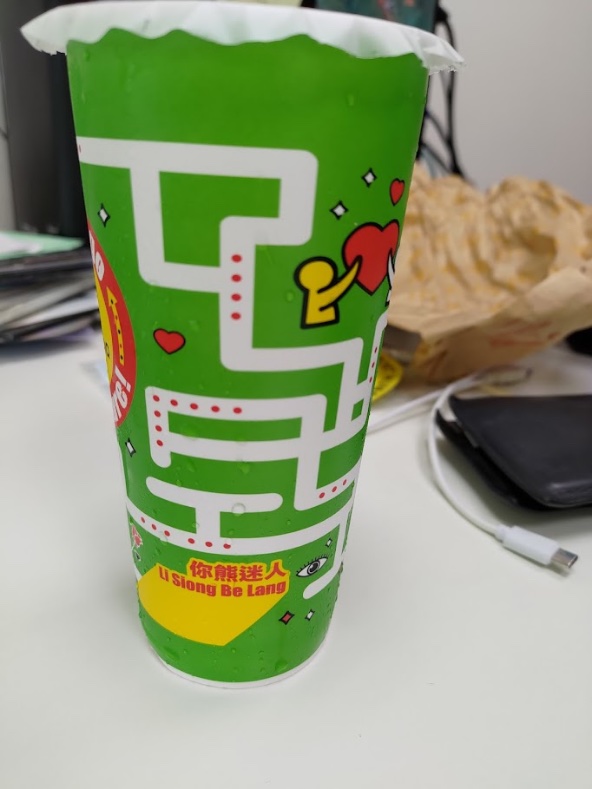"You bear lost person": writing Taiwanese
« previous post | next post »
From Mark Swofford, a cup of bubble tea with Taiwanese on it (romanized, Hanzified, and translated).
The following are the transcriptions, Romanizations, and translations of what is written on the cup.
Li Siong Be Lang
你熊迷人 lit., you-bear (the animal)-lost / charm-person
"You are most charming"
Goa Beh Ka Li Lam Tiau Tiau
我要把你攬迢迢 lit., I-want-pretransitive particle-you-embrace-far away
"I want to hug you tightly"
Lai Chit Tho
來七淘 lit., come-seven-dredge / strain / cleanse (and many other topolectal meanings)
"Come and play" (i.e., "come for a visit and have fun")
We have often talked about declining fluency rates in Taiwanese, with people becoming increasingly unable to speak, much less write, the language, but they still seem to have sufficient passive ability to understand a considerable amount of Taiwanese, even when written with many characters borrowed solely for their sound.
Selected readings
- "Morphemes without Sinographs" (11/18/21) — includes a discussion of the Taiwanese expression meaning "come and play", with an extensive bibliography documenting the travails entailed by a writing system that cannot directly represent all the morphemes of a given language for which it is used.
- "No character for the most frequent morpheme in Taiwanese" (12/10/13)
- "Taiwanese Morphemes in Search of Chinese Characters", by Robert L. Cheng (Zheng Liangwei), Journal of Chinese Linguistics, 6.2 (June, 1978), 306-314. A classic article that deserves to be enshrined in the Sinological Hall of Fame, morphology-phonology chamber, like the Yale linguist, George A. Kennedy's memorable "The Butterfly Case" (in Wennti, 8 [March, 1955]), which was a followup to his even more famous piece called "The Monosyllabic Myth" (in Journal of the American Oriental Society, 71.3 [1951], 161-166), both of which are reprinted in Tien-yi Li, ed., Selected Works of George A. Kennedy (New Haven: Far Eastern Publications, 1964), respectively pp. 274-322 and pp. 104-118. In these articles, Kennedy was writing about the fact that some Sinitic morphemes are disyllabic and how húdié 蝴蝶 ("butterfly") is a prime example. The case is recounted in brief in J. Marshall Unger's Ideogram: Chinese Characters and the Myth of Disembodied Meaning (Honolulu: University of Hawaii Press, 2004), p. 7.
[Thanks to Grace Wu and Melvin Lee]



David Marjanović said,
July 7, 2022 @ 2:48 pm
…Is that an accusative-case marker like Spanish a?
Victor Mair said,
July 7, 2022 @ 4:48 pm
It brings the object out in front of the verb.
Jonathan Smith said,
July 7, 2022 @ 5:18 pm
Better to present such sentences in a form faithful to the language under consideration, i.e.
guá beh kā lí lám tiâu-tiâu
I want acc. you embrace securely
'I want to hold you tight'
Re: written form, we could show some (sort-of) standard like Jiaoyubu (here 我欲共你攬牢牢) along with what is on the cup (我要把你攬迢迢) — noting that the latter employs meaning-motivated (要,把) and sound-motivated (迢) reapplications based on Mandarin; it doesn't make sense to give "literal" renderings based on such representations (above see esp. far, 'bear, etc.).
Re: David Marjanović's question concerning kā, I guess so as the gloss above suggests — there are clear similarities to Mandarin bǎ 把 and comparison with Spanish a might be very instructive — though to me it is odd to apply the term "case marker" to lexemes llike these in analytic languages… for instance Tw. kā doesn't even require an explicit following NP, unlike Mand. bǎ.
Victor Mair said,
July 7, 2022 @ 8:37 pm
To convey the effect of this type of writing on those who do not know Taiwanese.
David Marjanović said,
July 8, 2022 @ 12:46 pm
Thank you both.
Jerry Packard said,
July 10, 2022 @ 3:14 pm
The ‘ka’ here is not the ‘ba’ marker of the accusative, it is a separate morpheme meaning ‘with/to’, sort of like Mandarin ‘gen’.
David Marjanović said,
July 10, 2022 @ 3:22 pm
Ah.
Jonathan Smith said,
July 10, 2022 @ 9:29 pm
Above is best understood as ka7. Cf. from the Jiaoyubu dictionary
伊共錢扲牢牢
I kā tsînn gīm tiâu-tiâu.
He/she holds onto money tightly.
It is true that "acc." is an imperfect gloss, and also that ka7 can correspond to Mand. gen1 at times (cf. guá kā lí kóng 'I'm telling you'…), but 'hold you tight' would generally use ka7 and not kah4 'with' as in kah lí khì 'go with you'.